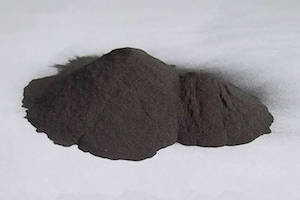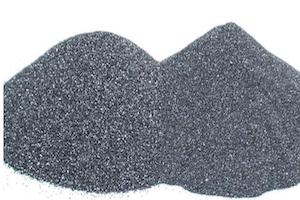Boron carbide is a black crystal with metallic luster, also known as black diamond, which belongs to inorganic non-metallic materials. At present, everyone is familiar with the material of boron carbide, which may be due to the application of bulletproof armor, because it has the lowest density among ceramic materials, has the advantages of high elastic modulus and high hardness, and can achieve good use of micro-fracture to absorb projectiles. The effect of energy, while keeping the load as low as possible. But in fact, boron carbide has many other unique properties, which can make it play an important role in abrasives, refractory materials, nuclear industry, aerospace and other fields.
Properties of boron carbide
In terms of physical properties, the hardness of boron carbide is only after diamond and cubic boron nitride, and it can still maintain high strength at high temperatures, which can be used as an ideal high-temperature wear-resistant material; the density of boron carbide is very small (theoretical density is only 2.52 g/ cm3), lighter than ordinary ceramic materials, and can be used in the aerospace field; boron carbide has a strong neutron absorption ability, good thermal stability, and a melting point of 2450 ° C, so it is also widely used in the nuclear industry. The neutron absorption ability of the neutron can be further improved by adding B elements; boron carbide materials with specific morphology and structure also have special photoelectric properties; in addition, boron carbide has a high melting point, high elastic modulus, low expansion coefficient and good These advantages make it a potential application material in many fields such as metallurgy, chemical industry, machinery, aerospace and military industry. For example, corrosion-resistant and wear-resistant parts, making bulletproof armor, reactor control rods and thermoelectric elements, etc.
In terms of chemical properties, boron carbide does not react with acids, alkalis and most inorganic compounds at room temperature, and hardly reacts with oxygen and halogen gases at room temperature, and its chemical properties are stable. In addition, boron carbide powder is activated by halogen as a steel boriding agent, and boron is infiltrated on the surface of steel to form an iron boride film, thereby enhancing the strength and wear resistance of the material, and its chemical properties are excellent.
We all know that the nature of the material determines the use, so in which applications does boron carbide powder have outstanding performance? The engineers of the R&D center of UrbanMines Tech. Co., Ltd. made the following summary.
Application of boron carbide
1. Boron carbide is used as polishing abrasive
The application of boron carbide as an abrasive is mainly used for grinding and polishing of sapphire. Among superhard materials, the hardness of boron carbide is better than that of aluminum oxide and silicon carbide, second only to diamond and cubic boron nitride. Sapphire is the most ideal substrate material for semiconductor GaN/Al 2 O3 light-emitting diodes (LEDs), large-scale integrated circuits SOI and SOS, and superconducting nanostructure films. The smoothness of the surface is very high and must be ultra-smooth No degree of damage. Due to the high strength and high hardness of sapphire crystal (Mohs hardness 9), it has brought great difficulties to processing enterprises.
From the perspective of materials and grinding, the best materials for processing and grinding sapphire crystals are synthetic diamond, boron carbide, silicon carbide, and silicon dioxide. The hardness of artificial diamond is too high (Mohs hardness 10) when grinding the sapphire wafer, it will scratch the surface, affect the light transmittance of the wafer, and the price is expensive; after cutting silicon carbide, the roughness RA is usually high and the flatness is poor; However, the hardness of silica is not enough (Mohs hardness 7), and the grinding force is poor, which is time-consuming and labor-intensive in the grinding process. Therefore, boron carbide abrasive (Mohs hardness 9.3) has become the most ideal material for processing and grinding sapphire crystals, and has excellent performance in double-sided grinding of sapphire wafers and back thinning and polishing of sapphire-based LED epitaxial wafers.
It is worth mentioning that when boron carbide is above 600 ° C, the surface will be oxidized into B2O3 film, which will soften it to a certain extent, so it is not suitable for dry grinding at too high temperature in abrasive applications, only suitable for polishing liquid grind. However, this property prevents B4C from being oxidized further, making it have unique advantages in the application of refractory materials.
2. Application in refractory materials
Boron carbide has the characteristics of anti-oxidation and high temperature resistance. It is generally used as advanced shaped and unshaped refractory materials and is widely used in various fields of metallurgy, such as steel stoves and kiln furniture.
With the needs of energy saving and consumption reduction in the iron and steel industry and the smelting of low-carbon steel and ultra-low carbon steel, the research and development of low-carbon magnesia-carbon bricks (generally <8% carbon content) with excellent performance has attracted more and more attention from domestic and foreign industries. At present, the performance of low-carbon magnesia-carbon bricks is generally improved by improving the bonded carbon structure, optimizing the matrix structure of magnesia-carbon bricks, and adding high-efficiency antioxidants. Among them, graphitized carbon composed of industrial-grade boron carbide and partly graphitized carbon black is used. Black composite powder, used as carbon source and antioxidant for low-carbon magnesia-carbon bricks, has achieved good results.
Since boron carbide will soften to a certain extent at high temperature, it can be attached to the surface of other material particles. Even if the product is densified, the B2O3 oxide film on the surface can form a certain protection and play an anti-oxidation role. At the same time, because the columnar crystals generated by the reaction are distributed in the matrix and gaps of the refractory material, the porosity is reduced, the medium temperature strength is improved, and the volume of the generated crystals expands, which can heal volume shrinkage and reduce cracks.
3. Bulletproof materials used to enhance national defense
Due to its high hardness, high strength, small specific gravity, and high level of ballistic resistance, boron carbide is especially in line with the trend of lightweight bulletproof materials. It is the best bulletproof material for the protection of aircraft, vehicles, armor, and human bodies; currently, Some countries have proposed low-cost boron carbide anti-ballistic armor research, aiming to promote the large-scale use of boron carbide anti-ballistic armor in the defense industry.
4. Application in nuclear industry
Boron carbide has a high neutron absorption cross-section and a wide neutron energy spectrum, and is internationally recognized as the best neutron absorber for the nuclear industry. Among them, the thermal section of boron-10 isotope is as high as 347×10-24 cm2, second only to a few elements such as gadolinium, samarium, and cadmium, and is an efficient thermal neutron absorber. In addition, boron carbide is rich in resources, corrosion-resistant, good thermal stability, does not produce radioactive isotopes, and has low secondary ray energy, so boron carbide is widely used as control materials and shielding materials in nuclear reactors.
For example, in the nuclear industry, the high-temperature gas-cooled reactor uses boron absorbing ball shutdown system as the second shutdown system. In case of an accident, when the first shutdown system fails, the second shutdown system uses a large number of boron carbide pellets Free fall into the channel of the reflective layer of the reactor core, etc., to shut down the reactor and realize cold shutdown, wherein the absorbing ball is a graphite ball containing boron carbide. The main function of the boron carbide core in the high temperature gas-cooled reactor is to control the power and safety of the reactor. The carbon brick is impregnated with boron carbide neutron absorbing material, which can reduce the neutron irradiation of the reactor pressure vessel.
At present, boride materials for nuclear reactors mainly include the following materials: boron carbide (control rods, shielding rods), boric acid (moderator, coolant), boron steel (control rods and storage materials for nuclear fuel and nuclear waste), boron Europium (core burnable poison material), etc.







